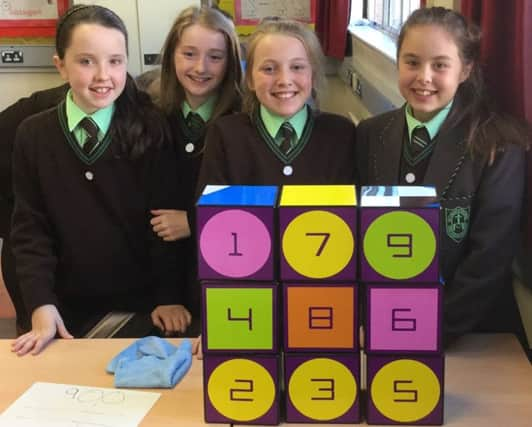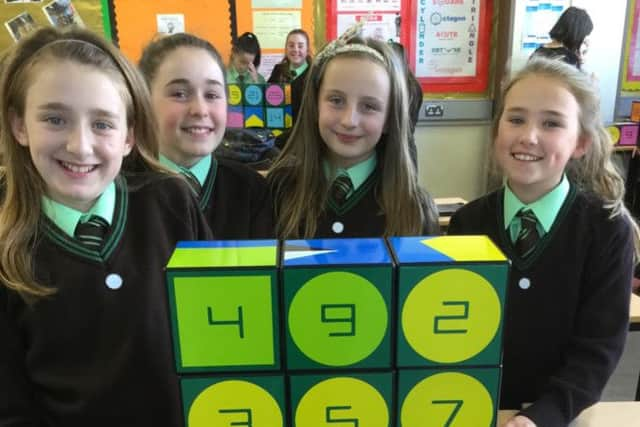Former Derry school teacher revolutionises Mathematics for girls


The findings of a joint research project focusing on Izak9, which was invented by Franz Schlindwein, a former school teacher from Derry, were presented on Friday (August 26) at the European Conference on Educational Research (ECER) in University College Dublin.
Employing Izak9 - an innovative resource designed to revolutionise classroom math learning by encouraging pupil interaction – resulted in a “significant” increase in girls’ enjoyment of mathematics both in Northern Ireland and the Republic of Ireland, the research shows.
Advertisement
Hide AdAdvertisement
Hide AdThe main focus of the research was on “improving” first year post-primary girls’ relationships with mathematics.


The joint project was motivated by the huge gender imbalance that exists in the uptake of courses in STEM (science, technology, engineering and maths); findings from large-scale international assessments that “girls generally did worse than boys in mathematics”; the fact that enjoyment and interest in maths are “key determinants” of future STEM participation and evidence that girls’ attitudes to maths “tend to deteriorate” after transition to secondary education.
One of the notable conclusions of the research is that child-centred pedagogical strategies - such as those involving the deployment of Izak9 in classrooms - appear to “improve girls’ attitudes to mathematics”. The research further indicates that such strategies “may be a form of liberatory mathematical pedagogy for girls”.
According to the researchers, the design of Izak9 “epitomises core tenets of feminist mathematical pedagogy” and they suggest that such child-centred approaches to teaching maths could help to offset gender bias in STEM participation.
Advertisement
Hide AdAdvertisement
Hide AdIzak9 is a unique learning resource which consists of 27 cubes - with different combinations of colour, number and shape. It is designed to stimulate mathematical thinking and interaction among primary or secondary level pupils with the help of animated on-screen characters named Helix and Abacus.


The research underpinning the ECER presentation on Izak9, entitled ‘Evaluating the impact of an innovative learning resource on the Affective Domain in Mathematics Education’, was conducted by Dr Ian Cantley, Queen’s University Belfast (School of Social Sciences, Education and Social Work) and Dr Mark Prendergast, Trinity College Dublin (School of Education).
Dr Cantley commented: “The results of this small-scale cross-national evaluation confirm that use of the Izak9 resource appears to improve girls’ interest in and enjoyment of mathematics. Our findings, which were consistent in both Northern Ireland and the Republic of Ireland, suggest that a larger scale study is warranted to investigate optimal modes of using Izak9 to capitalise on its potential to make mathematics more engaging for pupils.”
Dr Prendergast added: “This research provided a great opportunity for our pre-service mathematics teachers to incorporate an innovative concrete resource into their teaching. Izak9 proved to be very popular with students and for our pre-service teachers it highlighted the importance of using a broad range of teaching methods and manipulatives in the classroom to aid learning and increase enjoyment of mathematics”.
Advertisement
Hide AdAdvertisement
Hide AdIzak9 was invented by Franz Schlindwein, a former secondary school head of maths. He developed the idea for a changed teaching approach which stimulates mathematical thinking, encourages interaction, and boosts confidence.
Mr Schlindwein said: “I am absolutely delighted with the outcomes of this research, especially as it focused on secondary school children. The benefits of using Izak9 in primary schools are glaringly obvious but this joint project shows how effective and versatile it can be as a maths resource for children of all ages and for teachers in both sectors.
“Ian and Mark are passionate educators who - in the provision of the highest quality of teacher training for their own students - are prepared to take risks by not only embracing innovative practice but by carrying out extensive research themselves. I look forward to working with them in the future to create more innovative teaching and learning products or training that can help overcome the barriers prohibiting too many children from achieving success in this most wonderful of subjects.”
The research was supported by a grant from the Standing Conference on Teacher Education, North and South (SCoTENS). The European Conference on Educational Research (ECER), which is the annual conference held by the European Educational Research Association, was hosted this year by University College Dublin.
For further information on Izak9 log on to www.izak9.com